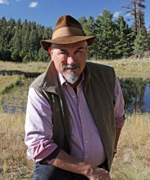 —Alan Dulaney
—Alan Dulaney
Apparently, the only thing that goes away on the Colorado River is water; the issues still remain. Most recently attention is again focused on the 20-year long drought that has diminished flows and storage on the Colorado River. On May 6, an article in the Arizona Republic reported on research that indicated that the drought that started in 2000 had been greatly exacerbated by hotter, drier conditions, turning it into a megadrought. Twenty years seems pretty “mega” to me.
Megadrought has been defined as any drought over a given area that is as severe as but longer than any drought seen in the instrumented 20th Century, and specifically includes severe droughts of several years duration as interpreted from the tree-ring record. Megadroughts occurred across much of the Colorado River drainage in the late 1500s, the end of the 1300s, the middle of the 1100s, and for much of the 9th Century. The first three co-occurred with notable cultural organizational shifts by the ancient Native American villagers who endured them, as interpreted from the archaeological record. These severe and sustained droughts resulted from natural hydrological variability and can be expected to recur. However, hotter and drier conditions have made the current megadrought much longer. Note that megadrought can occur in a region, such as the Upper Basin of the Colorado River system, while conditions in smaller regions elsewhere can be different. The reservoirs on the Salt-Verde River system were refilled during wet 2019 conditions which extended through March 2020 for the SRP watershed.
It is the current megadrought on the Colorado River system—and the fact that 40 million people are dependent on that water—that has produced negotiations on the organizational approach to lower flows and less storage in the reservoirs of the system. Megadrought does not mean that water will disappear from the Lower Basin overnight; sufficient water is stored in both Lakes Powell and Mead to allow typical deliveries through the end of 2021 according to the Bureau of Reclamation’s May update of their 24-month study. It is planning for megadrought that could last decades that is the driver.
On May 27, John Fleck, Director of the Water Resources Program at the University of New Mexico, and plenary speaker for the 2016 AHS Annual Symposium, presented a webinar on the Colorado River system and megadrought. He had several points to make. First, while everyone was looking at coronavirus, 2020 turned dry in the Upper Basin in April, a “sneaky drought” that was unexpected. Soil moisture levels proved low enough to take up much of the early runoff of a warm spring, and inflows to Lake Powell do not look promising. Second, the message that cooperation is always better than litigation seems to be taking hold. Negotiations amongst equals produce workable solutions, even incrementally; whereas courts and judges always seem to leave someone out. DCP was a good example. Fourth, people seem to be using less water on their own. California used less water in 2019 than in 1950, which is real progress. Yet curtailing demand cannot rest solely on agriculture. “Buy and dry” is not an acceptable strategy because the rural lifestyle cannot be wiped out to allow cities to grow ever larger and richer. Urban/rural social contracts can preserve lifestyles and water.
Demand management is the major method by which scarcity on the Colorado River, produced by the current megadrought, in turn produced by hotter and drier climatic conditions, can be ameliorated. Demand has not hardened yet, so we still have considerable savings in water usage to be achieved. Modern populations should have sufficient tools in the toolbox—increased conservation, access to groundwater as backup, recharge of reclaimed water, negotiated agreements incrementally building into an evolved social compact amongst multiple parties, and dollars to make it all work—to meet the challenge of megadrought.